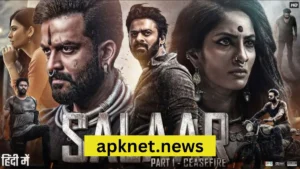Introduction
When Salaar hit theaters, it did more than entertain—it signaled a new era for regional Indian cinema. Directed by visionary filmmaker Prashanth Neel, starring the electrifying Prabhas in the lead role, and supported by a powerful ensemble cast, Salaar blends explosive action with emotional depth and mythic resonance. In this extensive article, we delve into every element—from story and performances to technique and audience response—highlighting why Salaar stands as a modern-day classic.
Indian cinema. Directed by visionary filmmaker Prashanth Neel, starring the electrifying Prabhas in the lead role, and supported by a powerful ensemble cast, Salaar blends explosive action with emotional depth and mythic resonance. In this extensive article, we delve into every element—from story and performances to technique and audience response—highlighting why Salaar stands as a modern-day classic.
1. Genesis and Pre-production
1.1 Vision and Creative Spark
The journey of Salaar began with Prashanth Neel’s fascination for larger-than-life heroes battling chaos. Building on his previous global hit, KGF, Neel envisioned a new protagonist—Salaar—whose internal struggle would match his external might.
1.2 Casting of Prabhas
Prabhas—known for his transformation into a pan-Indian star after Baahubali—was the ideal choice. His physicality, charisma, and ability to express complex emotions cemented him as the perfect embodiment of Salaar.
1.3 Supporting Cast and Roles
The film brought together an ensemble of strong performers: Shruti Haasan lending emotional grounding; Jagapathi Babu injecting menace; Sriya Reddy offering strength and grace; and a cadre of antagonists intensifying the dramatic stakes.
1.4 Scale and Scope
From regal palaces to urban warzones, Salaar was envisioned at a grand scale—setting up battle sequences, political intrigue, palace conspiracies, and mythic world-building in equal measure.
2. Narrative Overview
2.1 Setting
Set against the backdrop of a lawless kingdom, Salaar explores power dynamics between ruling elites, the oppressed masses, and outlaws on the fringe of society.
2.2 Prologue
The film opens with a mythic parable—a prince’s selfless sacrifice contrasted with systemic greed—signaling a larger conflict of power and conscience.
2.3 Emerging Hero
We meet Salaar in the midst of a brutal mission: rescuing a captive youth from a criminal stronghold. His ferocity and precision, coupled with clarity of purpose, establish him as a driven force for justice.
2.4 Entangled Alliances
Salaar joins forces with local rebels and civilians, while kingdom officials fight for hegemony. Among them are internal power struggles and a mysterious female ally whose identity and motives drive tension.
2.5 Conflict Unfolds
A conspiracy bringing together corrupt royals, enforcers, and social elites ignites war. Salaar must battle armies while reconciling conflicting loyalties and destiny.
2.6 Personal Reckoning
At the core is Salaar’s personal journey—born into bloodshed, torn between violence and honor, and ultimately confronting the legacy of his own actions versus necessity.
2.7 Climax
Filmed across mountain ranges and sandstorms, the climax is an operatic clash between will, honor, and survival—fought under igniting skies and collapsing structures.
2.8 Epilogue
The finale offers a moment of calm: a promise for change, influence reborn from duty, and a hero’s resting point amid hope and uncertainty.
3. Characters & Performances
3.1 Salaar (Prabhas)
A man burdened by power and violence—Prabhas delivers a performance marked by physical dominance and internal conflict. Without explicit revelation, viewers feel the depth of his broken past and desire for resolution.
3.2 Shruti Haasan’s Emblematic Role
She portrays a sharp, compassionate figure—navigating a patriarchal fortress while guiding Salaar through his humanity. Her performance matches his stride with strength and solemnity.
3.3 Jagapathi Babu and Antagonist Dynamics
As a scheming minister or baron with princely ambition, Jagapathi Babu’s gaze communicates a cauldron of duplicity. His character design balances menace with courtiers’ etiquette—creating a formidable trigger for conflict.
3.4 Ensemble of Allies
Supporting roles—from rebel commanders to palace guards—bring texture and dimension. Each performer contributes to the film’s world-building, delivering glimpses of loyalty, fear, sacrifice, and personal stakes.
4. Themes & Symbolism
4.1 Fate vs. Agency
Salaar’s journey is central to the theme of destiny—facing inherited blood debts and forced choices, he must reclaim agency by redefining who he chooses to be.
4.2 Cycle of Power & Resistance
The film juxtaposes ruling power and rebellion, tracing the surge of systems built on fear. It suggests both the corruptive nature of power and the potential for renewal through moral force.
4.3 Conflict as Purification
Violence, in the film’s tone, is not sensational—it’s utilitarian. It burns away corruption and allows new roots to form. While brutal, it becomes cathartic rather than nihilistic.
4.4 Honor in Morality
Where most crime dramas present casualty, Salaar aligns honor with action—Salaar’s morality is hidden within his actions of rescue and sacrifice. It posits that heroism need not be romanticized—it can be lived through hardship.
4.5 Mythic Underpinnings
Visual and thematic homages to myth serve as emotional shorthand—grand arches, cleansing rain, gate symbolism—evoke classical hero journeys and timeless transformations.
5. Production Design & Visuals
5.1 Major Locations
Filming spanned desert forts, abandoned ruins near hills, and stylized urban enclaves. Every location functioned as a character: emptiness became menace; architecture became political statement.
5.2 Costume & Symbolic Color
Salaar maintains a single color palette—dust, earth, steel—that blends warrior monasticism with realism. Opponents wear richer, patterned fabrics—an embodiment of corruption and excess.
5.3 Cinematic Scale
Long tracking, layered blocking, and heavy-light interplay accentuate scale. Battles are shot for impact—hundreds of extras. Every moment feels dynamic yet relational.
5.4 Lighting & Mood
Dusk and dawn dominate–the threshold times reflect the tension between destruction and renewal. Interiors use moody candles, torches, and minimal electricity to evoke despair and refuge.
6. Sound and Score
6.1 Musical Score
The soundtrack blends drums, strings, and ancient wind instruments—evoking tribal cultures. Strategic silence amplifies violence; percussion-driven crescendos intensify action.
6.2 Ambient and Real Sound
Close-mic recordings—sand underfoot, the clang of metal, distant horns—imbue scenes with immersion. It’s a world you can feel, not just see.
7. Action Choreography
7.1 Stunt Design
Real weapons, hand-to-hand combat, and environmental kills—no showy flips, but believable carnage.
7.2 Brutal Realism
Salaar isn’t a martial artist; he’s driven by purpose. Moments show exhaustion, struggle, pain, making his survival earned—not fanciful.
7.3 War Set-Pieces
Mass fight scenes—siege of gateways, cavalry-lances colliding—film techniques borrow from world cinema epics but remain grounded in scale and geography.
8. Direction and Editing
8.1 Prashanth Neel’s Vision
Intense pacing that allows emotional beats to breathe. Dialogues are minimal—power lies in gesture, glance, impression.
8.2 Structural Rhythm
Moments of violent intervention break up slower-paced scenes, keeping viewers off-balance. Emotional scenes are edited with deliberate pauses—a child’s reprieve, a stalled breath.
9. Reception and Box Office
9.1 Audience Reaction
Salaar made immediate cultural waves—memes, dialogues, emotional references. Salaar became shorthand for stoic heroism in a fractured world.
9.2 Critical Response
With some criticism for structural complexity and length, most praised performances, visual ambition, and tonal depth.
10. Cultural Impact
10.1 Empowering Regional Cinema
Salaar’s release marks a shift toward localized blockbusters—language, aesthetic, and story rooted in India but cinematic as global franchises.
10.2 Fashion and Style
Salaar’s costumes inspired rugged, savage-chic trends. Street styles echo his war-worn palette—functional, purposeful, bold.
10.3 Spoken Reverence
Salaar’s code of honor—collected in lines like “He fights for others, not his wealth”—became commonplace in meme culture and everyday speech.
11. Behind-the-Scenes Revelations
11.1 Physical Training
Prabhas underwent months of training—weapon handling, fight choreography, endurance conditioning—to authentically inhabit Salaar’s body.
11.2 Massive Logistics
Battles involved hundreds of extras, real horses, authentic period props, and permits to film in remote locations—complex coordination and local partnerships shaped production.
11.3 Safety Protocols
Stunts performed by actors required medical crews on set; rain machines, pyrotechnics, and practical fights were overseen rigorously.
12. Critiques and Areas of Debate
12.1 Running Time
At nearly three hours, some found the film too long. Critics argue a leaner edit could refine storytelling.
12.2 Narrative Clarity
The complex dynastic structure and multiple power dynamics can be confusing on first viewing. Though repeated viewings clarify character motivations, some cringe at exposition gaps.
12.3 Violence vs. Beauty
While visually stunning, some sequences approach graphic violence. The balance between beauty and brutality invites debate.
13. Legacy and Future
13.1 Franchise Building
Talks of a sequel or universe expansion are underway—either through Salaar’s origins, rival kingdoms, or aftermath of revolution.
13.2 Global Reach
Dubbed and subtitled versions are planned for international markets. Inclusion in global film festivals is under consideration.
13.3 Inspiring New Productions
Post Salaar, there’s a noticeable rise in high-budget action productions in regional India. Its success reaffirms that local stories can have universal impact.
14. Lessons for Filmmakers
-
Character First: Even massive epics benefit from emotionally grounded protagonists.
-
World-Build with Care: Architecture, lighting, and culture convey more than dialogue.
-
Action as Storytelling: Fight scenes reveal character and morality.
-
Visual Cohesion: A consistent palette supports franchise identity.
-
Balance Myth and Reality: Earned spectacle resonates longer than fantasy alone.
Conclusion
Salaar redefines blockbuster filmmaking in India—melding bombastic action with depth, mythic storytelling, and cultural authenticity. Anchored by Prabhas’ magnetic presence and Prashanth Neel’s uncompromising vision, it transcends conventional hero tales. In doing so, it elevates regional filmmaking to global relevance, proving that true epics are rooted in character as much as scale.

Hi i’m Ahmad Safeer A (Blogger Experties) with 5+ Years Experience in Blogging.